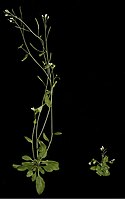
Photo from wikipedia
Flooding or submergence is one of the major environmental stressors affecting many man-made and natural ecosystems worldwide. The increase in the frequency and duration of heavy rainfall due to climate… Click to show full abstract
Flooding or submergence is one of the major environmental stressors affecting many man-made and natural ecosystems worldwide. The increase in the frequency and duration of heavy rainfall due to climate change has negatively affected plant growth and development, which eventually causes the death of plants if it persists for days. Most crops, especially rice, being a semi-aquatic plant, are greatly affected by flooding, leading to yield losses each year. Genetic variability in the plant response to flooding includes the quiescence scheme, which allows underwater endurance of a prolonged period, escape strategy through stem elongation, and alterations in plant architecture and metabolism. Investigating the mechanism for flooding survival in wild species and modern rice has yielded significant insight into developmental, physiological, and molecular strategies for submergence and waterlogging survival. Significant progress in the breeding of submergence tolerant rice varieties has been made during the last decade following the successful identification and mapping of a quantitative trait locus for submergence tolerance, designated as SUBMERGENCE 1 (SUB1) from the FR13A landrace. Using marker-assisted backcrossing, the SUB1 QTL (quantitative trait locus) has been incorporated into many elite varieties within a short time and with high precision as compared with conventional breeding methods. Despite the advancement in submergence tolerance, for future studies, there is a need for practical approaches exploring genome-wide association studies (GWA) and QTL in combination with specific tolerance traits, such as drought, salinity, disease and insect resistance.
Journal Title: Sustainability
Year Published: 2020
Link to full text (if available)
Share on Social Media: Sign Up to like & get
recommendations!